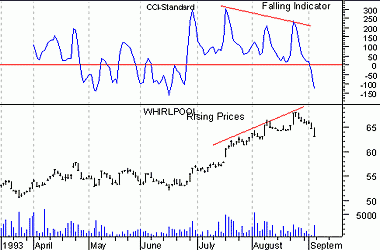The MACD, invented by Gerald Appel, stands for "Moving Average Convergence-Divergence". This tool identifies and measures the trend of the market and gives an indication of likely importance of that trend. The MACD (pronounced "Mack Dee") can be used over multiple time frame charts from 1-minute to monthly and quarterly charts.
The MACD, when used in its "line" form, incorporates three exponential moving averages (EMA's) to produce two chart lines. The first line is the fast MACD Line, and is almost always represented by a blue or green line. The second line is the slow Signal Line,or a 9-period EMA, which is represented by a red line. The standard MACD indicator is the result of plotting the fast and slow lines, and watching for when the fast line crosses the slow line.

Another way you can use the MACD is to look for certain patterns, such as a "Kiss of Death" where the MACD rises to just "kiss" the signal line before turning down. This is very bearish. Similarly there is the "Double Pump" where the MACD crosses over its signal line and then crosses back. This often brings a fast and relatively dramatic move in the direction of the cross-over.
Using a combination of hourly, daily and weekly MACD readings, you can fine tune your buying and selling. Some folks take the direction of your trade from the MACD indicator on your weekly chart, but picking your exact entry point from the MACD reading on the daily chart. (If it's a buy entry you're looking for, you'd want the weekly indicator to be bullishly rising but the daily indicator to dropping, so you get an advantageous entry price).
We have found that the weekly MACD is more useful when the direction of the fast line is considered instead of the cross over the signal line. One caveat, the MACD should only be considered on a closing basis. Many is the time that the Daily MACD appears to be giving a Sell during the day, but rebounds and actually generates a Buy. On the Weekly MACD, this is only more valid.




















